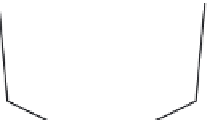Graphics Reference
In-Depth Information
Patch
j
Patch
i
Figure 8.41
The checkerboard pattern illuminates patches unevenly, but the integral of incident radi-
ance at patch
i
from patch
j
is about the same as if the illumination were evenly spread
over patch
j
.
The collection of patches includes one patch for each pixel in the image, and also
a separate collection of hypothetical patches for scene surfaces not visible from
the camera. The basic idea is that the high frequency illumination is smoothed
out by interreflections among the patches. As a result, the amount of global illu-
mination in the first captured image (under the first checkerboard light pattern) is
half of the full global illumination.
Rather than constructing a physical filter for the light source, the authors ac-
tually used a digital projector as a light source; the lighting pattern is created by
projecting an image of fully lit or entirely unlit pixels. This allowed experimen-
tation with a number of different lighting patterns, including various forms of the
checkerboard filter. Normally, the lighting pattern has the same number of ac-
tivated pixels as deactivated pixels, so that the light pattern and its complement
have the same total radiant power. But this is not strictly necessary; the constant
α
1
2
represents the fraction of the area of the light source that is covered (
α
=
for
the checkerboard patterns).
The paper uses a special notation for the radiance values of pixels in the cap-
tured images: the radiance of pixel
i
as captured by camera
c
is denoted by
L
[
c
,
i
]
in general;
L
+
[
and
L
−
[
denote the radiance values in the images with the
basic checkerboard and its complement, respectively. A
d
subscript is added for
the direct radiance, and a
g
subscript is added for the radiance from the global (in-
direct) component. The separation of direct and indirect components is concisely
formalized in this notation:
c
,
i
]
c
,
i
]
L
[
c
,
i
]=
L
d
[
c
,
i
]+
L
g
[
c
,
i
]
.
denotes two-bounce radiance (source
to some patch
j
, to patch
i
, to the camera);
L
gg
[
Further distinctions can be made:
L
gd
[
c
,
i
]
denotes radiance from patch
i
after at least two previous bounces. These two values form a separation of the in-
direct radiance:
L
g
[
c
,
i
]
c
,
i
]=
L
gd
[
c
,
i
]+
L
gg
[
c
,
i
]
. The relevance comes in considering
the indirect component
L
g
[
c
,
i
]
in the first partially illuminated image.


























